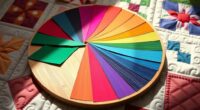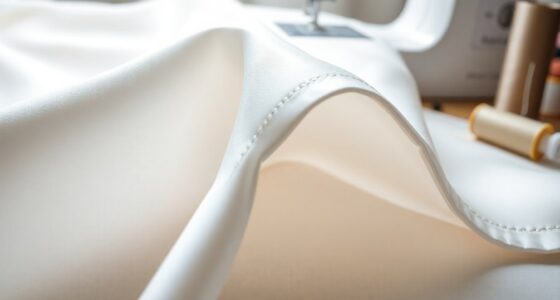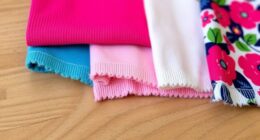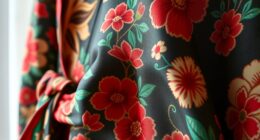To master repeat patterns with hand-drawn motifs, focus on creating seamless designs by practicing flawless repetition, balancing colors for visual harmony, and adjusting contrast for impact. Test your patterns at different scales to guarantee they look great everywhere, from small fabrics to large wallpapers. Developing an intuitive sense for proportion and flow helps craft versatile, professional-looking patterns. Keep exploring these principles more deeply, and you’ll release endless creative potential with your designs.
Key Takeaways
- Understand pattern creation principles, including flawless repetition and color harmony, to craft seamless, professional-looking motifs.
- Test your hand-drawn motifs at various scales to ensure clarity and impact across different applications.
- Use contrasting colors strategically to enhance visual interest and emphasize pattern details.
- Balance motifs and details to maintain cohesion while allowing flexibility in pattern scalability.
- Practice developing an intuitive sense of balance and repetition to create versatile, engaging repeat patterns.
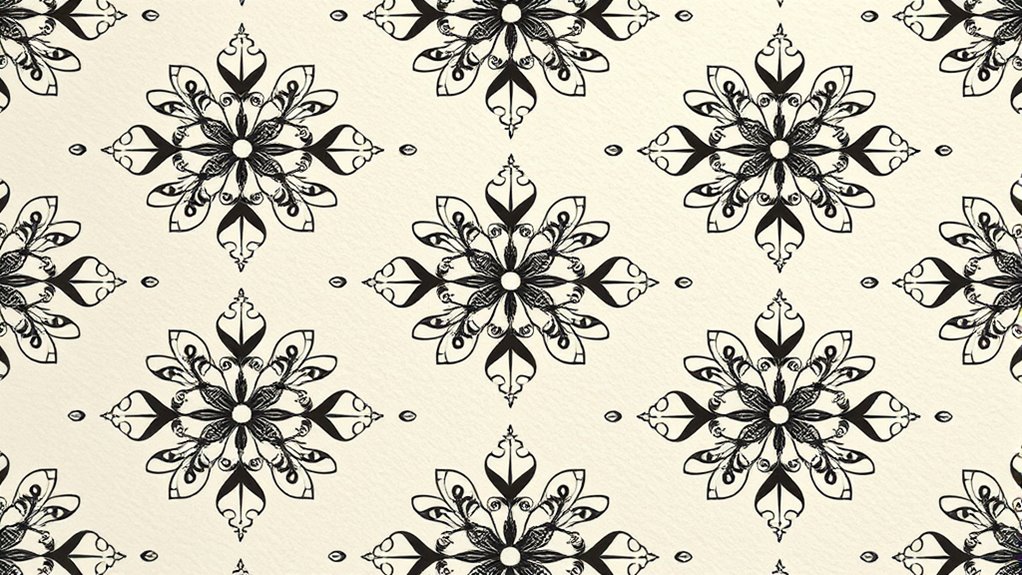
Have you ever wondered how designers create seamless, eye-catching patterns that repeat flawlessly? The secret lies in understanding the fundamentals of pattern design, especially how to balance color harmony and guarantee pattern scalability. When you master these elements, your hand-drawn motifs can transform into professional-grade repeat patterns that captivate and engage. Incorporating techniques to optimize contrast ratio can also help ensure your patterns have the right depth and visual impact. Color harmony plays a vital role in making your patterns visually appealing. By choosing colors that complement each other, you create a balanced and cohesive look that’s pleasing to the eye. Think about using analogous color schemes for a soft, harmonious effect or contrasting colors for a bold, dynamic statement. As you draw your motifs, consider how these colors will interact when repeated. This understanding helps prevent awkward clashes or jarring transitions across the pattern. Experiment with different color combinations, keeping in mind the mood or message you want to convey. When you establish a harmonious color palette early in your design process, it becomes easier to create a seamless pattern that feels unified and intentional.
Pattern scalability is another essential aspect to take into account. When you design motifs for repeat patterns, you need to think about how they will look at various sizes. A motif that works well at a small scale might lose its impact when enlarged, or vice versa. To address this, you should test your motifs at different scales, adjusting details as needed. Simplify overly intricate designs for larger repeats to maintain clarity, and add details to smaller motifs to keep them interesting. This flexibility ensures your pattern remains effective regardless of size, whether it’s on a fabric, wallpaper, or digital background. When your motifs are scalable, you gain versatility and confidence in your designs, knowing they’ll work across multiple applications.
Creating seamless, eye-catching repeat patterns with hand-drawn motifs requires intentionality and careful planning. Focus on establishing color harmony from the start—think about how your chosen palette will unify the pattern. At the same time, consider pattern scalability by testing your motifs at various sizes and adjusting details accordingly. With practice, you’ll develop an intuitive sense for balancing these elements, allowing your hand-drawn designs to translate effortlessly into professional patterns. The more you experiment and refine, the more natural it becomes to craft seamless repeats that are both beautiful and adaptable. In the end, mastering these core principles turns your hand-drawn motifs into versatile, eye-catching patterns that can elevate any project or product.
Frequently Asked Questions
What Are the Best Tools for Creating Hand-Drawn Motifs?
You’re wondering about the best tools for creating hand-drawn motifs, especially for digital illustration and pattern composition. To get started, use a graphics tablet or stylus with software like Adobe Illustrator or Procreate. These tools let you sketch freely, then refine your motifs seamlessly. With digital brushes and layers, you can experiment with different styles easily, making your pattern design process more efficient and creative.
How Do I Choose Color Schemes for My Patterns?
When choosing color schemes for your patterns, focus on color harmony to create a cohesive look. Use contrast techniques like complementary or analogous colors to add visual interest and balance. Think about your pattern’s mood and audience, and pick colors that evoke the right feelings. Experiment with different combinations, and don’t be afraid to test how contrast enhances your motifs, ensuring your pattern stands out beautifully.
Can Hand-Drawn Motifs Be Digitized Effectively?
You can definitely digitize hand-drawn motifs effectively. Use high-resolution scanning to capture details, and follow scanning best practices like proper lighting and clean equipment. Once scanned, you can enhance and clean your motifs with digital tools, making them ready for repeat pattern creation. Digitization techniques like vectorization can also help turn your sketches into scalable, editable digital files, ensuring your hand-drawn art maintains its charm in your designs.
What Are Common Mistakes to Avoid in Pattern Repetition?
Did you know that 45% of pattern designers struggle with seamless repeats? When avoiding mistakes, pay attention to misaligned motifs and inconsistent spacing. You might think your design is perfect, but small errors can disrupt the flow. Always double-check your repeats, use guides or grids, and guarantee motifs align properly. This keeps your pattern cohesive and professional, making your hand-drawn motifs truly stand out.
How Can I Ensure Seamless Pattern Alignment?
To guarantee seamless pattern alignment, focus on perfecting your tiling technique. Use alignment techniques like snapping your motifs to guides or gridlines, and double-check that edges match precisely. Test your pattern by creating a larger tile to see if the design repeats seamlessly without gaps or overlaps. Regularly zoom in and out to spot misalignments, and adjust your motifs until your pattern tiles smoothly for a flawless, continuous look.
Conclusion
Now you know the secrets to stunning repeat patterns, so seize the style and start sketching! With your hand-drawn motifs, you’ll create mesmerizing, cohesive designs that catch the eye. Remember, practice perfects patterns—patience, persistence, and passion bring your visions vividly to life. So, step confidently, sketch boldly, and let your unique design dreams develop into dazzling, delightful repeats that truly stand out.

